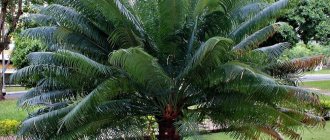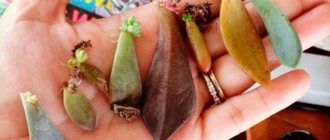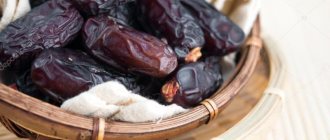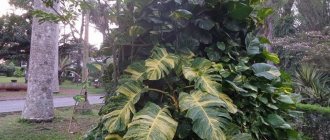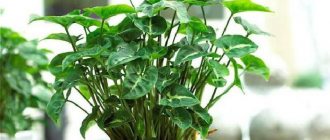The sago palm belongs to the Cycad family, which includes 200 species. It is also called cycas or cycad. Under natural conditions, the culture grows in Australia, the Pacific Islands, and India.
You can grow this crop yourself. However, for this you need to follow the rules for planting work and provide the plant with comprehensive care.
Description of the sago palm
The main decoration of the cicada is the long feathery leaves of a rich, bright green color. This is a dioecious plant. Female specimens are distinguished by reddish or yellowish pubescent leaves against a background of bright greenery. Male cycads form knobby projections – microstrobilae – at the base of the trunk.
Important! In home cultivation, only female specimens are used, since male microstrobili have a very unpleasant odor.
Cycad seeds ripen in cones that usually form on the upper part of the trunk of female plants. These are loose formations that consist of modified young leaves. The ovules are located on these leaves. However, you should know that cycas does not produce seeds under indoor conditions.
When grown wild in subtropical or tropical conditions, the cycas grows up to fifteen meters in height. Houseplants usually grow to a maximum of 150, more often up to 50-80 centimeters.
The sago palm grows very slowly - no more than 3 centimeters per year, and rarely produces new leaves - up to three per year.
The leaves grow from the central part of the trunk, covered with brown scales - remnants of the bases of dead leaves. A powerful vein runs through the central part of the leaves, which has no branches. Segments of young leaves are usually curled like a snail, but over time they straighten out. The lifespan of the leaves is up to three years.
Cycas is also characterized by a very thick trunk, although in home growing conditions it develops rather poorly.
Curled or snail-shaped
Not a small variety, Tsikas Curled, or snail-shaped: it stretches up to 8 meters in height. Young leaves grow strictly parallel and are covered with many small spines. With age, the spines remain, but the leaves move from a vertical plane to a parallel one. The leaf blades are 150-200 cm long and grow in bunches.
The pinnate leaves are interspersed with lanceolate leaves with dense veins in the middle. The color is bright, juicy and, since the edges of the leaves are darker and the centers are light, a very unusual color transition is obtained. It grows many babies and floating seeds, due to which it spreads very quickly in its natural habitat.
In the photo below is the variety Tsikas Curled, or snail-shaped:
Tsikas Curled
Origin of the cycad
Cycas is a plant from the tropics and subtropics; Australia and the countries of Southeast Asia are considered its homeland. It is believed that this particular plant to some extent became the progenitor of modern spruce trees, as well as ferns and horsetails.
Interesting! Cycas is such an ancient plant that we can safely say that representatives of this genus were closely acquainted with dinosaurs.
It is believed that such longevity of this species in an almost pristine state is due to a rare ancient symbiosis of five different organisms: the cycad itself - the host, a fungus, two types of bacteria, as well as blue-green algae.
The distribution area of the cicada is extremely wide - it does not grow in open ground only in northern Europe and Antarctica. At home, it can also be grown beyond the Arctic Circle.
Siamese
The homeland of this species is the savannah forests of Southeast Asia. Compared to others, the Siamese cicus is not tall - it does not extend more than two meters - with rather narrow feathery leaves and a trunk that is thick in the middle and thin on top. The length of the leaves is about 100 cm, the width is no more than 5 mm. The plates are painted bluish-white, the petioles are covered with tiny but sharp spines right down to the base. He loves light and high humidity in the surrounding world.
Cycas Siamese
Cycas: types and varieties, photos
The plant is currently represented by a little more than twenty species, among which the most common are C. curled, C. drooping (turned away), C. comb-shaped, C. media, C. non-thorny, C. Rumpha, C. Tuara.
The most popular is the drooping cicada, or turned away, also known as Ts. revoluta. Thanks to its lush, but at the same time very compact crown, it has become a real favorite of designers who use it for indoor landscaping. It is very often found in gardens and parks of the tropics and subtropics. The following varieties of drooping cycas are especially loved by flower growers:
- diplofoliolum with forked, double-pinnate leaves, creating the effect of an extremely lush crown;
- corrugata - a very rare, but very decorative variety with striped leaves and a bottle-shaped trunk;
- alba, or golden cicada, notable for the pale yellow color of young, barely blossoming leaves, which gradually changes to a rich green color;
- variegata is the most popular among variegated varieties.
Other types of cycas are much less common in indoor floriculture, mainly due to the high demands on living conditions, as well as due to the fact that their sizes are not suitable for indoor spaces.
Mealybugs
Mealybug At an early stage, a strong soap solution will help: dissolve a tablespoon of soap in a liter of boiling water and wipe the trunk and leaves, and then rinse the plant in the shower. Repeat the procedure after a week. At an advanced stage, only chemicals will help:
- "Aktellik";
- "Aktara";
- "Rogor";
- "Phosfamide";
- "Nurell-D";
- Spruzit-A ESchadlingsfrei.
How to choose the right place for a flower
Since illumination primarily affects the normal growth of the cicada and its development, the place for it must be selected with special care, no matter what time of year it is outside the window.
Important! The duration of daylight hours for cycas should not be less than 12 hours. Therefore, choose the brightest room for the plant and place it near the window.
The best option is south-east or south-west windows. At the same time, it is important to organize additional lighting during the period when there will be a lack of natural light.
If the plant does not have enough light, its leaves will not fully develop, will turn yellow early and fall off. Also, the lack of light affects the growth of the cycas: it stops growing.
In the warm season, it is advisable to take the pot with cycad out into the open air. At the same time, unlike most house plants, it is not at all afraid of direct sunlight, although it needs to be accustomed to it gradually.
Important! Cycas is poisonous; when determining a place for it, it is necessary to ensure that it is inaccessible to children and pets.
Rumpha
The Rumpha cycas is native to the island nation of Sri Lanka. This representative can reach a height of 15 meters, and due to the growth of leaves in bunches and vertically, the plants have a funny, disheveled appearance. The leaf blades are painted in light shades with a cold tint, lanceolate-linear in shape, up to 30 cm long and up to 20 mm wide. This species is considered the largest of all known to botanists.
The seeds are ovoid, flat, 30 mm wide and 40-45 mm long. The sarcotesta (peel) is clearly orange in color with a small hint of brown. It grows in rain and coastal forests, as well as on coral limestone (sand) dunes.
The photo below shows Tsikas Rumpha:
Tsikas Rumpha
Substrate, watering and feeding of cicada
Cycas has no special requirements for the substrate. Standard soil for palm trees suits it perfectly. The mixture is made up of turf and leaf soil, peat and sand, taken in equal quantities.
It is recommended to add a small amount of humus, charcoal and fine pebbles, within 20% of the total composition. Such a substrate will most fully correspond to the soil in which cycads grow in nature.
The growing container must be sized to match the volume of the roots - it is 2-3 centimeters larger in diameter to allow the root system to develop.
Any pot for cycads will do, ceramic or plastic - there is no difference. The only thing you should consider when choosing is that moisture evaporates less in plastic pots, so you need to water the plant in it less often than in ceramics. But the clay container is heavier, which means it is more stable. This is especially important for large plants.
Important! The drainage layer is poured at least 3 centimeters. Expanded clay, crushed brick or medium-sized pebbles are usually used as drainage. An important condition is the presence of drainage holes.
The cicada requires rare but plentiful watering. In summer it is watered once every 5-7 days. In winter, watering is more rare - once every 10-12 days. Cycas tolerates drought better than excess moisture. Therefore, after watering, the water from the pan must be drained. Water for irrigation should be at room temperature, soft, and well settled.
Cycas are fed from early spring until mid-autumn once every 15 days. In the autumn-winter period, fertilizing is carried out once a month; you can completely do without it.
Fertilizers designed specifically for palm plants are used. Mullein diluted with water 1:20 is used as organic matter. The cycad also accepts horse manure diluted in water well.
Important! Fertilizers containing calcium or magnesium are not suitable for cycads.
Conditions for keeping a cycad
Like all tropical and subtropical plants, cycas loves warmth. However, it is very hardy and can survive short frosts, although with some loss of decorative value. It does not have a pronounced rest period, but during the season of short daylight hours it is advisable to organize a lower temperature for it - 15-17 degrees.
Cycas is not particularly demanding of moisture. However, a level of 70-80% is considered optimal. If the air in the room is dry, which is typical in winter, the containers with the plant are placed on a tray with expanded clay or pebbles, which are periodically moistened. You can also cover the soil in the pot with a layer of moss.
It is periodically necessary to remove dust from cycas leaves, since contaminated leaves are more likely to be attacked by pests. Usually, to maintain cleanliness, the leaves are sprayed with warm water.
Important! When spraying leaves, you must ensure that water does not get on the trunk.
Cycas should be protected from drafts, as they can cause yellowing of the leaves. The plant will also benefit from pruning leaves that have lost their decorative properties due to their age or damage by diseases and pests. A leaf dying due to natural reasons stands out among its fellows by its strong slope towards the ground.
How does a cycad reproduce?
Reproduction by shoots
If normal conditions are created for the cicada at home, fully complying with all the rules, it periodically forms shoots (offshoots) from the trunk.
Important! The procedure is carried out very carefully to prevent damage to the trunk of the mother plant.
The process of separating the offspring is as follows:
- The plant is carefully removed from the soil.
- The offspring is separated with a sharp disinfected instrument (scalpel or knife). At the same time, the condition of the root system is usually checked.
- After separating the shoot, it is necessary to treat the cut on the main trunk with crushed charcoal or cinnamon powder.
- The leaves are carefully removed from the cut shoot, the cut is treated with an antifungal drug, then with a root formation stimulator.
- The offspring is planted for rooting in well-moistened coarse sand or coarse perlite. At the same time, it is buried approximately three-quarters of the size of the cone.
- Until complete rooting, the container with the shoot is kept at a high temperature - about 30 C - in a slightly shaded place. Important! The substrate must be constantly moistened.
- During the first week, the shoots require watering every 2-3 days. Then watering is reduced.
- Cycas shoots take a long time to take root, up to six months; some varieties require 8-9 months. The offspring is carefully transplanted into a standard substrate for cycads when its roots grow and become stronger.
Propagation by seeds
This method is little used for home cultivation, since it is quite difficult to obtain cycas seeds; the plant blooms in adulthood, when it is over 50 years old. It is more suitable for greenhouses or open ground.
However, in recent years, it has become possible to purchase cycad seeds from online stores or brick-and-mortar seed stores.
In this case, the seeds are first soaked in warm water for 24 hours. After soaking, they are laid out on a layer of perlite or well-washed coarse sand, slightly pressing them into the substrate.
Seeds take a long time to germinate, the process lasts two, usually three months. When the seedling forms its first true leaf, it is transplanted into the soil required by the adult plant.
Reproduction
Seeds
On the one hand, growing cycas from seeds is not difficult: pre-process it, plant it and take care of it. On the other hand, it is difficult to find viable seeds, since for such tasks the cycas needs to be grown in greenhouse conditions, and only an experienced specialist can do this.
The action diagram is as follows:
Soak the seeds for 24 hours in clean warm water with the addition of a growth stimulator.- Plant it in the ground, slightly deepening it, cover the container with transparent film or glass and place it in a warm, bright place.
- Organize bottom heating: the temperature for growing should be at least +30 degrees. Ventilate and water the soil daily. Sprouts will appear in a month and a half. Do not tear the shell off the seeds: it will fall off on its own. As soon as the first leaf has grown, the sprout can be transplanted into a permanent pot.
The optimal time for planting seeds is spring.
By shoots
Proceed according to the following plan:
Cut off (using a disinfected blade) a lateral shoot from the mother plant: it should be strong, with adventitious roots and healthy leaves. Treat the wound with activated carbon or garden pitch.
Dry the part for a day or two in the fresh air: a protective film should form at the cut site.
Plant the shoot in a pot with soil, after dipping its lower part in Kornevin powder. The temperature regime should be the same as when working with seeds: +28 – 30 degrees, high humidity, light. Organize a mini-greenhouse for 10 months: the shoot will not take root before then.
Poisonous or not?
The cicada tree, indeed, contains poison, but both children and adults can touch it - it poses a danger only if the flour from the trunk and seeds gets into the stomach. Don't let your pets chew it, otherwise they will get poisoned.
Cycas transplant
Cycas is one of those plants that do not particularly favor transplantation, since their roots react painfully to shocks of this kind. However, at a young age it is recommended to replant it every two or three years.
More mature plants, older than 5-6 years, are replanted only if it becomes obvious that the roots in the pot are crowded, usually every 5-6 years. The need for replanting will be indicated by roots protruding through the drainage holes.
The pot for replanting is selected so that its diameter is 2-3 centimeters larger than the diameter of the trunk. The depth of the pot should be 2-2.5 times the diameter. For example, if a container with a diameter of 15 centimeters is required, its depth must be at least 30 centimeters.
It is believed that any season is suitable for transplanting cycas, but preference should still be given to the spring period, before active growth of the cycad begins.
Important! Cycas are not replanted while new leaves are forming.
Before transplanting, about a third of the leaves are removed from the plant, cutting off the oldest ones first. The root system requires special attention when replanting, since deformation of the roots or their breaking off, especially thick ones, can lead to putrefactive diseases.
The plant is replanted by transshipment, without affecting the earthen lump surrounding the roots. It cannot be shaken off or washed off.
Purchase
How to choose in a store
A healthy cicada will have even, natural-colored buds, a strong trunk, without rot or damage. Choose a plant with at least three already formed leaves.
First steps after purchase
For 2 weeks after purchase, the cicada needs to be put in a separate room: check to see if there are any dangerous insects on us? As soon as the period has expired, the cicada can be transplanted into new soil.
Cycas pests
The scale insect settles on the leaves, sucking the juices from them. The leaves first turn yellow, then begin to dry out and fall off.
Spider mites appear when the air humidity is too low, entangling the leaves with a thin web. The leaves also lose color, dry out, and fall off.
Thrips inhabit the lower parts of leaves; their appearance is also associated with insufficient air humidity combined with low temperature. Whitish dots and small spots appear on the leaves. Then the leaf acquires a light brown color with a silvery coating.
The preferred means of combating these sap-sucking insects are folk ones - a solution of laundry soap, zoo shampoos, infusions of garlic or onions. Plants are treated several times at intervals of 5-7 days, picking off pests manually whenever possible.
If traditional methods do not help, you have to resort to treating plants with chemicals - Actellik, Fitoverm, etc.
Mealybugs also appear on plants at low humidity, especially during the off-season. Often its appearance is provoked by the accumulation of dust on the leaves. The scale insect is recognized by the appearance of white sugary formations.
Important! Causative agents of sooty fungus often settle on mealybug secretions.
It is best to remove scale insects manually using cotton swabs soaked in vodka or a solution of laundry soap. If the pest colony is too large, it is recommended to use preparations based on imidacloprid (Biotlin, Iskra, Tanrek, etc.).
In this case, treatment is carried out weekly for one and a half months.
Shchitovka
Scale insects The appearance of scale insects is indicated by yellow spots on the leaf blades, bending and bare branches, cracked bark, and many colonies of larvae on all parts of the plant. Pests attack weakened plants with reduced immunity. You can cope with them using both chemical and biological drugs:
- "Aktara";
- "Aktellik CE";
- "Kinmiks";
- "Danitol";
- "Sumi Alpha."
Cycad diseases and their treatment
The most dangerous diseases of cycads are rot of the root system or trunk. Putrefactive lesions are caused by fungi.
To heal a plant, first remove it from the pot, carefully wash the roots with warm water and carefully examine it.
Important! If the trunk or roots are affected by rot at a level of 70% or higher, it will no longer be possible to cure the cycad.
Partial lesions are removed with well-sharpened sterile instruments. Decaying areas are cut out to healthy tissue, which is light brown in color. Then the cleaned areas are sprinkled with crushed charcoal or activated carbon and left to dry for several hours.
Roots affected by rot are darker in color than healthy ones. They are also soft to the touch and do not have small secondary roots. All affected areas are cut out, then the roots are placed in an antifungal solution. After soaking for half an hour in the fungicide, the roots are treated with a root growth stimulator, and the cut areas are filled with wax or candle paraffin.
After these procedures, the plant is planted in a small pot. Clean coarse-grained sand is used as a substrate, which is pre-disinfected by steaming or calcination.
As a rule, the recovery period for a cicada lasts up to six months. All this time you need to carefully monitor the plant in order to repeat the treatment in time if the need arises.
Important! During recovery, the cycad often sheds its foliage, which during this period takes away from it the strength required for a complete recovery.
The aboveground part of the cycas affected by rot in most cases leads to the death of the plant. Therefore, you can only try to save the lateral processes that can be rooted.
Leaf spot is a less dangerous disease of cycads. It occurs due to violation of plant care rules: lack of fertilizing, drafts, low humidity, excessive watering. Treatment in this case consists of restoring the regimen of all care activities.
Problems of growing cycads
The leaves have turned yellow - what to do?
The main reasons for the appearance of yellowness on leaves are excessive watering, excessive fertilizing, unsuitable soil, and lack of light. This problem also occurs when there is a lack of nitrogen or iron, other nutrients, or due to alkalization of the substrate.
The problem is resolved by restoring the required maintenance regime. If the reason is an overabundance of fertilizers, the soil can be washed by spilling it with plenty of water.
Important! When washing the soil, the water that has flowed into the pan is immediately removed.
Yellowing of the lower leaves, the oldest in age, is usually associated with the natural processes of their death. To make young leaves appear faster, old ones are cut off.
Young leaves are too long but underdeveloped
The problem is related to insufficient lighting. The cicas must be moved to a well-lit place, and the defective leaves must be removed, as they will quickly turn yellow and fall off.
Brown color of leaf tips
There are several possible reasons:
- not enough nutrition to form new leaves;
- excess fertilizer;
- sunburn;
- freezing of leaves;
- putrefactive diseases.
In the first case, you need to restore the normal regime of feeding the plant. In the second, rinse the soil well several times. If a cycad has a sunburn or, conversely, frostbite on the foliage, it needs to choose a place where it will be free from prolonged exposure to direct sunlight and protected from exposure to cold air. If the leaves turn brown due to disease, it is necessary to urgently treat the plant.
No new leaves appear for two years or more
The problem can be caused by violations of living conditions (lack of light, heat, minerals) or diseases. In this case, you first need to carefully examine the entire plant, including the root system. If the disease is excluded, the problem is solved by restoring the necessary conditions.
Why does it dry out?
The dying off of the lower tier of leaves indicates a natural reason for what is happening: this is how the cycas gets rid of old leaves. But in other cases, the problem is too dry air and lack of moisture in the soil. Make the watering more abundant, install a humidifier or a saucer of water nearby, and from time to time give the cicada a bath in a warm shower.
Tsikas in the interior
Cycas, like all its close relatives, belong to relict plants. This is the reason for their external attractiveness and beneficial effect on humans.
The appearance of the cycad is very impressive. Any plant, even a flowering one, loses its decorative value next to it. Therefore, in interior design, he is a soloist who needs space, but does not need a “back-up dancer.”
The cicada is usually placed indoors so that it can be seen from any point. That is why it is undesirable to bring it closer to the walls. Only if there is not enough space is it placed closer to the corner, while preventing its crown from touching the walls to avoid deformation of the leaves.
The unusual property of cycad - its calming, calming effect is best used when arranging relaxation corners: next to a comfortable sofa or armchair. Moreover, this property should be used both in residential and office premises.
Despite the more than venerable age of cycads, they fit perfectly into the modern interiors of any phytodesign solution. The main thing is to choose a container that matches the style.
The only limitation to the use of cicada in the interior is its size: it is completely unsuitable for small rooms, since it itself is large in size, and its pointed leaves “tear” the space.
Numerous reviews of cycas and its cultivation at home confirm both its decorative value and calming effect on the psyche. Properly placed in the room, it adds coziness and is reminiscent of southern countries, with which many people associate memories of a wonderful time - summer vacation.
Final part
Judging again by the reviews of the owners of this amazing plant, as well as by discussions on forums (FrauFlora, BestFlowers, woman.obovsem.com, iplants.ru), the cicada brings more joy to the house than trouble - caring for it is not difficult .
On the mentioned forums you can also find a lot of useful tips on caring for the cycas at home - how best to position it, what to feed it, how to make soil for it, how to treat it, how to urgently resuscitate it.
